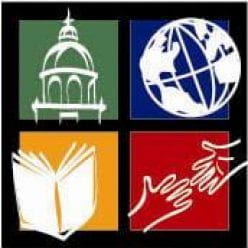This Winter term’s Global-Health-themed GIS programming kicked off with a bang as students filled the DOC House on Occom Pond on the first weekend of the term to participate in a global pandemic simulation. More than 40 scholars, several GIS mentors, and Dickey Center staffers came together for this 10th Anniversary Celebration of GIS to be assigned diverse roles with which to negotiate a reasonable solution to a simulated, yet sophisticated, disease outbreak in the US. Notably, the event was also attended by Charles Tseckares ’57 and his wife Lorna Tseckares.
Designed in 2009 by professionals from the National Defense University and the US Naval War College, the Global Tempest Simulation used by the students relied on a wide distribution of multi-agency roles and a complex pandemic spread model that afforded a deep look at the many parameters that make pandemics so dangerous. An adaptation of the game had been brought to the Dickey Center in 2016 and its success inspired this year’s iteration which was specially designed for the GIS class of 2023. The game’s intricate logic was facilitated by Rick Johnson of the National Defense University, David Sampson of the US Naval College, senior military consultant George Greenleaf, and Peter Pellegrino of the US Naval War College, described by Mr. Johnson as “one of the greatest war game designers.”
The simulation kicked off with a very convincing news bulletin detailing the emergence in Asia of a new and highly contagious virus that had begun to make its way around the world. The “GNN” newscasters warned of the virus’ destabilizing potential, international resource shortages, and the threat of social unrest. As the briefing came to a conclusion, the students dispersed to meet with their individual departments and facilitators. Arranged into groups representing the Department of Defense, the Department of Homeland Security, the Department of Health and Human Services, and state and regional representatives, students were briefed on the powers and responsibilities of their offices. Introducing an even greater degree of granularity, they were also advised on the the conventional restrictions of their specific ranks in these departments and of the administrative, bureaucratic, and social hurdles they might have to consider.
Afterwards, students representing these departments broke into their regional groups, representing the administrative public health infrastructure of the Eastern, Central, and Western regions of the US. Their mission was clear but not simple: minimize the number of infection-related casualties and minimize the economic loss related to the outbreak.
In the Central Regional briefing room, students began to emphatically enact their roles as they poured over pre-arranged materials that went deeper into each “officer’s” duties and limitations. This information allowed the newly-minted public health officials to make recommendations for the group’s consideration. Summer Jing ’20, a GIS mentor, playing the Director of the CDC, quickly recommended mass vaccinations across her entire region. Meanwhile, Jake Zikan ’23, playing the Governor, accepted the recommendation, among complaints, of Kenneth Wu ’23, playing the Mayor of Dallas, TX, to keep all schools open during the outbreak.
The conversation remained complex at every table. Students weighed casualty estimates and specific percentages of resources to be allowed, populations to be affected, and means of distribution.
In the Western Region headquarters, limitations in stockpiles of vaccines were considered along lines of the distribution of the most vulnerable populations and the most sensitive sites to new infection. The Assistant Secretary of Health at the Department of Health and Human Services, played by Emma Barska ’23, recommended redistributing some vaccines to smaller cities. The Regional Governor, played by Adam Stein ’23, accepted her proposal as well as a measure from the Vice Chairman of the Joint Chiefs of Staff, played by Caleb Benjamin ’23, to buy one specific vaccine known as Dormagen due to efficacy and cost.
Most students had their phone calculators out, crunching numbers from dense spreadsheets and passing figures left and right. Designated individuals were taking notes on boards and shuttling between top-rank members to ensure the proper communication of decisions.
In the Eastern Region, with only four minutes left before the first round of deliberation closed so that decisions could be entered into the model, decisions were getting tough. Director of the Joint Chiefs of Staff, Brandon Hill ’23, spoke about the urgent need to issue restrictions on flights coming from Asia and to close crucial transportation infrastructure. The Regional Lead Director of the Transportation Security Administration, Anna Sandell ’23, questioned whether her office had been given the economic capabilities to increase screenings in the desired airports. She would have to wait for the next round of the simulation to get her answer.
The news of the first run of the model was received by an anxious and excited crowd of students as a mixed bag of blunders and successes. The West coast experienced a significant population collapse due to an initial policy of a sustained focus on economic loss mitigation. The central region remained stable, having lost the most money but having saved the most lives. The Eastern region was getting worse; they lost as many lives as their Western compatriots but saved the most money.
Namrata Ramakrishna ’20 , a Dickey Center intern who also participated in the simulation, noted that she felt that “all the students learned a lot from all of the different interdisciplinary features of the model since it showed a more realistic process of how an epidemic would spread and be contained.”
In the end, the were no clear winners nor losers. The simulation attempted to demonstrate the dilemmas inherent in issues of this type and it was the demonstration of the high degree of uncertainty and of the need for cooperation that made the program a successful lesson. In all, it is clear that this activity will likely be kept as a staple of the Great Issues Scholars Global Health curriculum for years to come.







